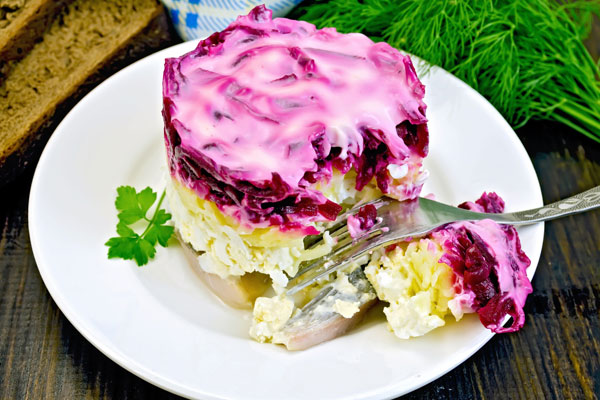What's so Russian about Russian food?
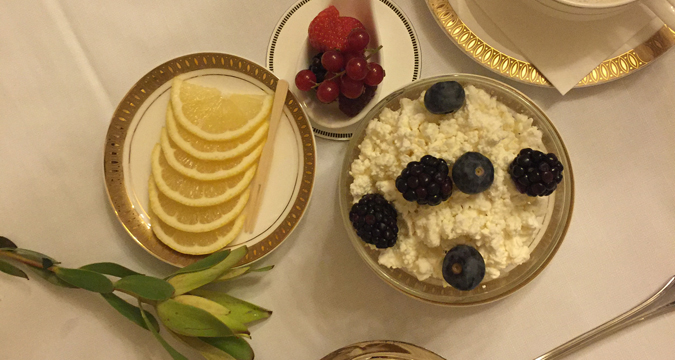
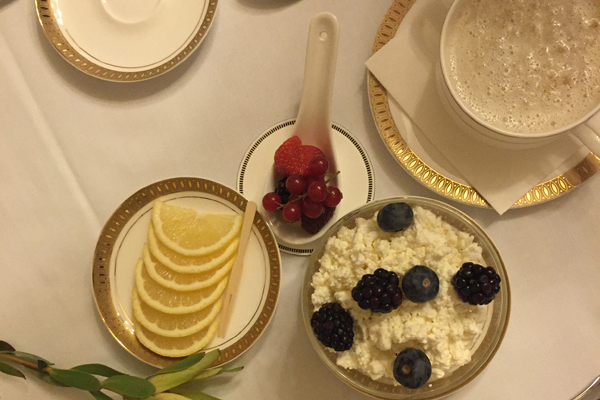 Russian breakfast: tvorog and porridge. Source: Aleksandra Efimova
Russian breakfast: tvorog and porridge. Source: Aleksandra Efimova
On a recent trip to Russia, I picked up three cookbooks dating back to the 1800s that were originally written for housewives of that time. Although updated for the modern cook, these books still show their roots, including such valuable information as how to choose and clean the best rabbit for cooking!
Perusing these books I was reminded of how strongly the kitchen is at the center of the Russian lifestyle and point of view. People often ask me, “What is Russian food like?” and that’s an interesting question. Russia is a vast country, with 11 time zones and multiple climates from northern to southern, from forest to seacoast, from flatlands to mountains, so there is a lot of variety in cuisine.
 Inside the Russian restaurant. Source: Aleksandra Efimova
Inside the Russian restaurant. Source: Aleksandra Efimova
An even more interesting question might be, “What is Russian eating like?” because across all those time zones and climates, in the most rural and the most cosmopolitan areas of the country, there is a common focus and attitude toward preparing and eating food.
I remember from my childhood in St. Petersburg that eating was central. No matter how many family members or guests were in the house, they all seemed to end up in the kitchen. To this day, I’m not sure how they all fit; the kitchen in the first house I remember was only five square meters in size (about 50 square feet). Our next kitchen was a couple of square meters larger, but still very small, and it’s hard to believe how many people would squeeze into such a tiny area.
But squeeze into it they did, because the kitchen is truly the heart of the Russian home. Everyone gravitates to the kitchen and they can sit for hours around the table, enjoying a meal together but also sharing conversation, stories, jokes and songs.
The table would also be filled with a fabulous amount and variety of food. Special-occasion meals in Russia are generally served family style both in homes and in restaurants, where you are typically seated at a table already set with cold appetizers such as Olivier salad (Russian potato salad), green salads, cold cuts, herring and salmon and pate sandwiches. Next come hot appetizers and always at least one soup, rich in vegetables such as beets, cabbage, carrots or tomatoes and followed by hot main courses.
 Olivier salad.Source: Aleksandra Efimova
Olivier salad.Source: Aleksandra Efimova
As a child, it seemed to me that the food just kept coming and the table just kept expanding – I don’t remember dishes ever leaving the table and we would often go back to delicious morsels from previous courses. It seemed that there was only one real rule: remove the herring and beets before bringing in the Napoleons and cakes for dessert.
Despite the vastness of the country, there are certainly some foods that are distinctively Russian. The beet soup borscht, for example, can be found throughout most of Russia, although with regional variations. My grandmother’s version was much lighter than the thick Siberian version, in which you could probably stand up a spoon.
Soups in general are universal throughout Russian cuisine. I can only remember a few days a year when we didn’t have soup at our house, and these were only when it was very hot outside (at least we thought so, although it was probably only about 75 degrees Fahrenheit). Vareniki (known as pierogi in Polish) remain very common – a dumpling filled with just about anything such as meat, eggs and onions, apples, cottage cheese, in sour versions served with soup and sweet versions for dessert – as are golubtsy (stuffed cabbage rolls), pelmeni (another kind of dumpling), various stroganoffs (thick cream sauce usually with mushrooms) and complex dishes such as chicken Kiev.
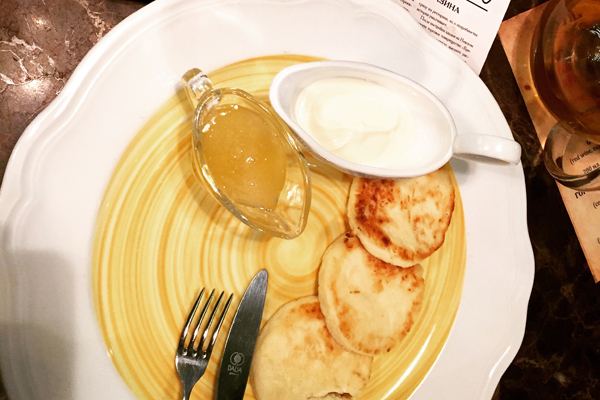 Syrniki. Source: Aleksandra Efimova
Syrniki. Source: Aleksandra Efimova
Bread is universally present and eaten with almost every meal. Most common is black bread, based on rye flour, and this bread was traditionally given as a welcome greeting to guests arriving in a Russian village or home. “Breaking bread together” is how Russians build relationships and it has also made the difference between survival and starvation during many eras of world history (such as the siege of Leningrad in World War II).
Cuisine in the more cosmopolitan areas of Moscow and St. Petersburg was influenced by Russia’s admiration of elements of the culture of European countries such as France, Italy and Belgium. Peter the Great and his successor Catherine the Great wanted St. Petersburg to be a window to Europe. This influence was reflected in smaller ways, such as court dress and cuisine, and larger ones, such as the magnificent architecture of the city.
The fall of the Soviet Union brought a second wave of outside influence to the Russian table, but in a significantly different way. In the 17th and 18th centuries, European elements were integrated into the Russian way of eating. In the post-Soviet 20th and 21st, it’s more a matter of expanding options, with new restaurants and recipes featuring other European, Asian, Indian and Middle Eastern dishes, alongside traditional Russian foods. In both cases, most of the effects can be seen in the cities, while the rural areas tend to stay closer to tradition.
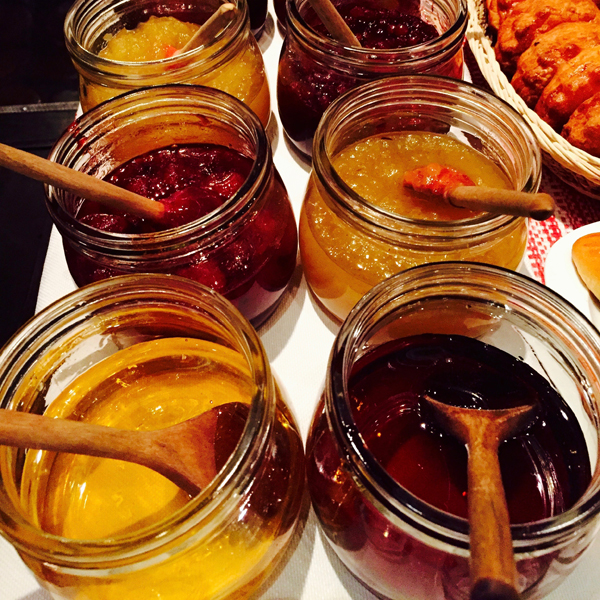 Varenye (Russian jam). Source: Aleksandra Efimova
Varenye (Russian jam). Source: Aleksandra Efimova
Regardless of era or region, there is something special about eating in Russia. Overall, the food is healthy and delicious and cooked with love and attention, which takes time. Typical dishes require effort and attention, for selecting and preparing ingredients and putting them together with care, often according to a time-honored family recipe.
Considering the amount of time spent around the table, the number of dishes served, and the constant presence of bread and other starches, I’m sometimes asked how Russians stay fit. I do think that the food is healthy, partly because it’s close to nature with few, if any, artificial additives or processes. Portions tend to be small, like little tastings of a variety of flavors, rather than a large amount of one dish.
Also, like many European countries, Russia’s largest meal is at midday, allowing the body to digest food more thoroughly before sleep. It probably helps that dinners are eaten slowly, with time taken to socialize between bites and courses. And it certainly takes plenty of carbohydrates and fats to stay warm in the cold temperatures that Russia experiences throughout the year.
 Aleksandra Efimova. Source: Angelika Poletaeva
Aleksandra Efimova. Source: Angelika Poletaeva
As an American with Russian roots, I love to prepare and serve beautiful meals and share them with wonderful friends, whether those meals feature typically Russian dishes or not. Spending time over the dinner table – and continuing to converse over a leisurely cup of hot tea – has its own Russian flavor, of congeniality and interaction mingled with the complex tastes of food enjoyed together.
Read more: What is so Russian about Russian fashion?
All rights reserved by Rossiyskaya Gazeta.
Subscribe
to our newsletter!
Get the week's best stories straight to your inbox

